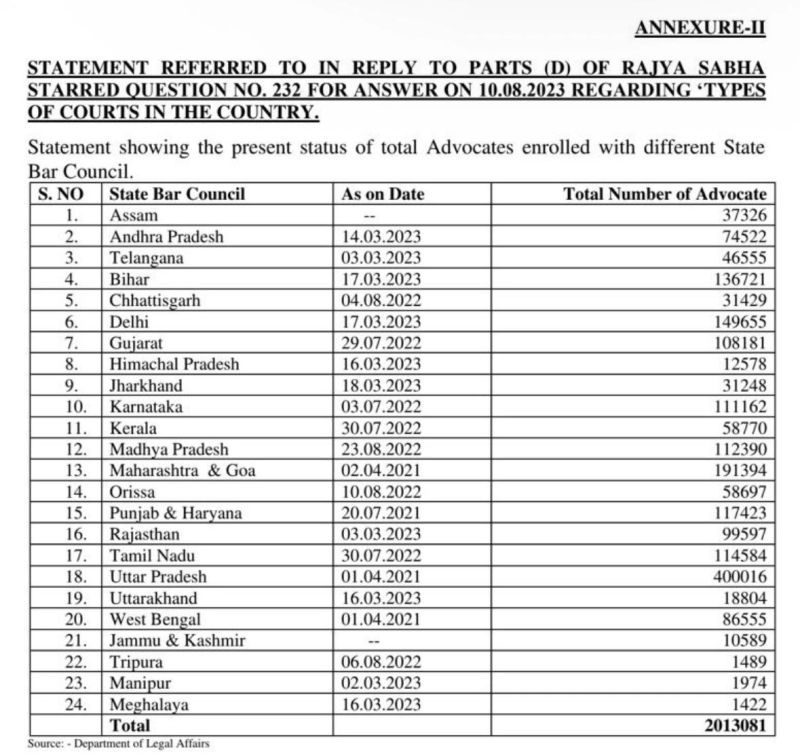India Has 2 million Lawyers But Are We Using Talent Well ?
Page Contents
India Has 2 million Lawyers But Are We Using Their Talent Well?
Mministry of Law & Justice has informed Rajya Sabha that as of August 2023 there are 20,13,081 registered advocates in India. Given India’s population of roughly 1.438 billion (2023 estimate) this works out to roughly 140 advocates per 100,000 people (i.e., about one advocate for every 710 people). So As of August 2023, the Ministry of Law & Justice informed the Rajya Sabha that there are 20,13,081 registered advocates in India that’s around 140 advocates per 100,000 people, or one advocate for every 710 citizens. To put this in perspective for example Israel: 694 lawyers per 100,000 people & European average: 164 lawyers per 100,000 On paper, India seems adequately represented. Yet the reality within the profession tells a very different story.
The Oversupply Dilemma
India’s early progress was built by lawyers who wrote laws. Its next leap may depend on lawyers who can rethink, reform, and regulate them for a digital, globalized world. “Each year, thousands of students graduate from more than 1,500 law colleges across India. However, only a small fraction perhaps 5% or less sustain long-term careers in litigation. Most young advocates quit within the first five years, moving to corporate jobs or non-litigation roles because of low initial earnings and limited access to quality briefs. The reasons are structural:
- A handful of senior advocates corner the major cases and clients.
- Junior lawyers are left with minor procedural work or “IA arguments.”
- There’s no predictable income path for new entrants.
- When supply far exceeds demand, value and professional sustainability inevitably declines.
From the Constituent Assembly to Corporate Boards: The Changing Role of Lawyers in India’s Policy Landscape
In 1952, when the first Lok Sabha convened, 26% of its members were lawyers. Today, that number has dropped to just 7%. This marks a sharp decline from India’s founding era, when figures like Gandhi, Nehru, and Jinnah, all British-trained barristers, led the freedom movement and helped frame the Constitution. Lawyers were once the architects of India’s democratic institutions. Yet, as politics professionalized and the economy liberalized, the locus of legal influence began shifting from courtrooms and legislatures to boardrooms and ministries.
The New Policy Architects
Research by Bhargavi Zaveri (National Institute of Public Finance and Policy) reveals that corporate law firms in India are increasingly shaping policy and regulatory frameworks. By working closely with ministries like Finance and Commerce, these lawyers provide real-time feedback on laws, compliance models, and investment structures — influencing how India’s economic governance evolves. While corporate lawyers constitute barely 10,000 of India’s 2 million advocates, their policy footprint is expanding rapidly.
Rethinking Entry and Quality :
India could consider a tiered entry system, similar to the Chartered Accountancy profession, where only a certain percentile of candidates pass through advanced levels. A national litigation aptitude or advocacy exam could ensure that only those with the required practical competence are allowed to represent before courts. This wouldn’t merely restrict numbers, it would raise quality, create respect for the craft of litigation, and make the system more sustainable.
Beyond Numbers: Reducing the Case Burden :
The deeper issue isn’t only the number of lawyers, it’s the number of pending cases. About 35% of all court matters involve government departments, many stuck for years due to procedural or policy inertia. We need reforms that:
- Simplify laws and procedures to prevent avoidable litigation.
- Separate two parallel court systems one for regular civil/criminal matters and another for administrative or compliance-related disputes.
- Use AI-based case management and document automation to resolve routine matters faster.
- If we reduce unnecessary cases, we free up both judges and advocates to focus on substantive justice rather than paperwork.
The Real Reform: Quality Over Quantity :
India doesn’t lack legal minds it lacks an efficient legal ecosystem. We should aim to:
- Train fewer, but better-prepared, advocates.
- Make litigation a viable career choice.
- Streamline government litigation.
- Let technology unclog procedural backlogs.
Until we do, even 10 million lawyers won’t make justice faster only more crowded.
Why This Shift Matters
- As India grapples with complex legal-technology issues from data privacy (Aadhaar) to AI regulation and ESG compliance the need for lawyers who can bridge law, policy, and business has never been greater.
- The policy vacuum left by declining lawyer participation in politics is being filled, in part, by in-house counsels and law firms.
- This marks a quiet but profound evolution from lawyers as political leaders to lawyers as policy advisors.
The solution isn’t merely to produce more lawyers it’s to create an environment where good lawyers can thrive, courts can move faster, and justice regains its rightful pace.

